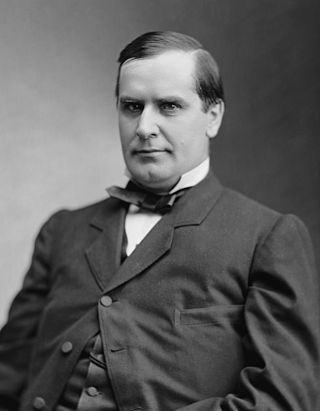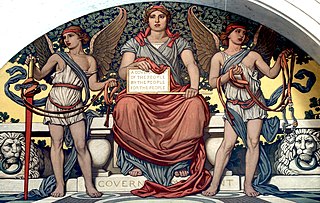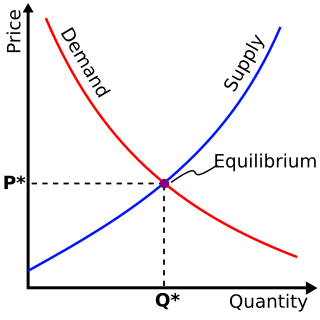
The economy of Paraguay is a market economy that is highly dependent on agriculture products. In recent years, Paraguay's economy has grown as a result of increased agricultural exports, especially soybeans. Paraguay has the economic advantages of a young population and vast hydroelectric power. Its disadvantages include the few available mineral resources, and political instability. The government welcomes foreign investment.
A variety of measures of national income and output are used in economics to estimate total economic activity in a country or region, including gross domestic product (GDP), Gross national income (GNI), net national income (NNI), and adjusted national income. All are specially concerned with counting the total amount of goods and services produced within the economy and by various sectors. The boundary is usually defined by geography or citizenship, and it is also defined as the total income of the nation and also restrict the goods and services that are counted. For instance, some measures count only goods & services that are exchanged for money, excluding bartered goods, while other measures may attempt to include bartered goods by imputing monetary values to them.
A tariff is a tax imposed by the government of a country or by a supranational union on imports or exports of goods. Besides being a source of revenue for the government, import duties can also be a form of regulation of foreign trade and policy that taxes foreign products to encourage or safeguard domestic industry. Protective tariffs are among the most widely used instruments of protectionism, along with import quotas and export quotas and other non-tariff barriers to trade.

The Tariff Act of 1890, commonly called the McKinley Tariff, was an act of the United States Congress, framed by then Representative William McKinley, that became law on October 1, 1890. The tariff raised the average duty on imports to almost 50%, an increase designed to protect domestic industries and workers from foreign competition, as promised in the Republican platform. It represented protectionism, a policy supported by Republicans and denounced by Democrats. It was a major topic of fierce debate in the 1890 Congressional elections, which gave a Democratic landslide. Democrats replaced the McKinley Tariff with the Wilson–Gorman Tariff Act in 1894, which lowered tariff rates.
Purchasing power parity (PPP) is a measure of the price of specific goods in different countries and is used to compare the absolute purchasing power of the countries' currencies. PPP is effectively the ratio of the price of a market basket at one location divided by the price of the basket of goods at a different location. The PPP inflation and exchange rate may differ from the market exchange rate because of tariffs, and other transaction costs.
Dumping, in economics, is a form of predatory pricing, especially in the context of international trade. It occurs when manufacturers export a product to another country at a price below the normal price with an injuring effect. The objective of dumping is to increase market share in a foreign market by driving out competition and thereby create a monopoly situation where the exporter will be able to unilaterally dictate price and quality of the product. Trade treaties might include mechanisms to alleviate problems related to dumping, such as countervailing duty penalties and anti-dumping statutes.
The National Policy was a Canadian economic program introduced by John A. Macdonald's Conservative Party in 1876. After Macdonald led the Conservatives to victory in the 1878 Canadian federal election, he began implementing his policy in 1879. The protective policy had shown positive responses in the economy with new industries flourishing Canada's economy in the 1880s. John A. Macdonald combined three elements as a strategy for the post-Confederation economy. First, he called for high tariffs on imported manufactured items to protect the manufacturing industry. Second, he called for a massive expansion of physical infrastructure, such as roads and railroads. Finally, enabled and supported by the former two, he promoted population growth, the building of the Canadian Pacific Railway, and the fostering of immigration to Western Canada. Macdonald campaigned on the policy in the 1878 election, and defeated the Liberal Party, which supported free trade. It lasted from 1879 until sometime in the early 1950s.

Non-tariff barriers to trade are trade barriers that restrict imports or exports of goods or services through mechanisms other than the simple imposition of tariffs. Such barriers are subject to controversy and debate, as they may comply with international rules on trade yet serve protectionist purposes.

In economics, output is the quantity and quality of goods or services produced in a given time period, within a given economic network, whether consumed or used for further production. The economic network may be a firm, industry, or nation. The concept of national output is essential in the field of macroeconomics. It is national output that makes a country rich, not large amounts of money.
Foreign exchange reserves are cash and other reserve assets such as gold and silver held by a central bank or other monetary authority that are primarily available to balance payments of the country, influence the foreign exchange rate of its currency, and to maintain confidence in financial markets. Reserves are held in one or more reserve currencies, nowadays mostly the United States dollar and to a lesser extent the euro.
The Balassa–Samuelson effect, also known as Harrod–Balassa–Samuelson effect, the Ricardo–Viner–Harrod–Balassa–Samuelson–Penn–Bhagwati effect, or productivity biased purchasing power parity (PPP) is the tendency for consumer prices to be systematically higher in more developed countries than in less developed countries. This observation about the systematic differences in consumer prices is called the "Penn effect". The Balassa–Samuelson hypothesis is the proposition that this can be explained by the greater variation in productivity between developed and less developed countries in the traded goods' sectors which in turn affects wages and prices in the non-tradable goods sectors.
Trade can be a key factor in economic development. The prudent use of trade can boost a country's development and create absolute gains for the trading partners involved. Trade has been touted as an important tool in the path to development by prominent economists. However trade may not be a panacea for development as important questions surrounding how free trade really is and the harm trade can cause domestic infant industries to come into play.
Clarence Lyle Barber was a Canadian economist and academic.
The international dollar, also known as Geary–Khamis dollar, is a hypothetical unit of currency that has the same purchasing power parity that the U.S. dollar had in the United States at a given point in time. It is mainly used in economics and financial statistics for various purposes, most notably to determine and compare the purchasing power parity and gross domestic product of various countries and markets. The year 1990 or 2000 is often used as a benchmark year for comparisons that run through time. The unit is often abbreviated, e.g. 2000 US dollars or 2000 International$.
Rules of origin are the rules to attribute a country of origin to a product in order to determine its "economic nationality". The need to establish rules of origin stems from the fact that the implementation of trade policy measures, such as tariffs, quotas, trade remedies, in various cases, depends on the country of origin of the product at hand.
An eco-tariff, also known as an environmental tariff, is a trade barrier for the purpose of reducing pollution and improving the environment. These trade barriers may take the form of import or export taxes on products that have a large carbon footprint or are imported from countries with lax environmental regulations. A carbon tariff is a type of eco-tariff.
In economics, a tariff-rate quota (TRQ) is a two-tiered tariff system that combines import quotas and tariffs to regulate import products.
Manufacturing in Hong Kong consists of mainly light and labour-intensive industries. Manufacturing started in the 19th century after the Taiping Rebellion and continues today, although it has largely been replaced by service industries, particularly those involving finance and real estate.
Taxation in Malta is levied by the State and it is administered by the Commissioner for Tax and Customs. The total tax revenues in 2014 amounted to €2.747 Billion, which represents 34.6% of the Maltese GDP. The main sources of tax revenue were value-added tax, income tax, and social security contributions.
A destination-based cash flow tax (DBCFT) is a cashflow tax with a destination-based border-adjustment. Unlike traditional corporate income tax, firms are able to immediately expense all capital investment. This ensures that normal profit is out of the tax base and only super-normal profits are taxed. Additionally, the destination-based border-adjustment is the same as how the Value-Added Tax treat cross-border transactions—by exempting exports but taxing imports.









